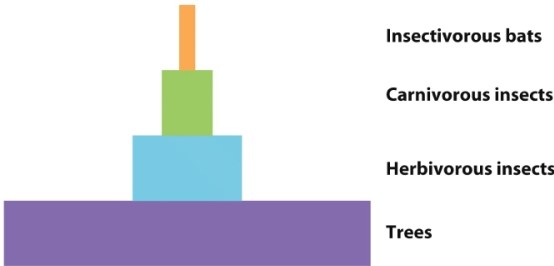Multiple Choice
Consider the following representation of the biomass of a forest community. This diagram also correlates with the trophic structure of the community. The size of the rectangle represents the relative biomass at each trophic level. Based on the representation below, what conclusion can be drawn about the transfer of energy between the organisms in each trophic level? 
A) The transfer of energy is less than 100% between trophic levels, but the rectangles representing biomass should be larger, that is, there should be more herbivorous insects because the trophic level that includes trees is large enough that it should support more herbivorous insects.
B) The transfer of energy is incomplete between trophic levels because insectivorous bats consume organisms from both trophic levels with insects.
C) The transfer of energy is incomplete between trophic levels because trees lose most of their energy in the form of heat, so it is not available for higher trophic levels.
D) The transfer of energy is incomplete between trophic levels because organisms consume some of the energy in metabolic processes and it therefore cannot be available for the higher trophic levels.
E) The transfer of energy between each level looks like much more than 10%, therefore insects are especially efficient metabolizers of biomass.
Correct Answer:

Verified
Correct Answer:
Verified
Q110: Lampreys are known to attach themselves to
Q111: In the example of the predator/prey web
Q112: Which of the following is expected to
Q113: You sample the solid waste of three
Q114: Most symbiotic interactions require a long-term association
Q116: Overlap of niches can be minimized through:<br>A)increased
Q117: The Arctic has been a key research
Q118: In the example of the giant kelp
Q119: Competition can occur over resources such as
Q120: The broadest level in a trophic pyramid